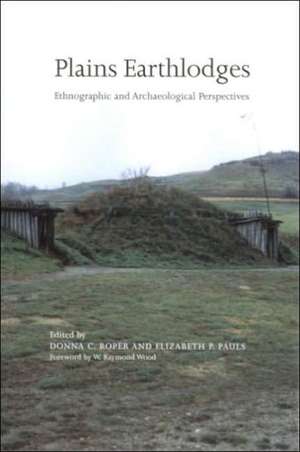Plains Earthlodges: Ethnographic and Archaeological Perspectives
Editat de Donna C. Roper, Elizabeth P. Pauls Contribuţii de Kenneth L. Kvamme, Jennifer R. Bales, Margot P. Liberty, Steven C. Lensink, Michael Scullin, Donald J. Blakeslee Cuvânt înainte de W. Raymond Wooden Limba Engleză Paperback – 10 apr 2005
A survey of Native American earthlodge research from across the Great Plains.
Early explorers initially believed the earthlodge homes of Plains village peoples were made entirely of earth. Actually, however, earthlodges are timber-frame structures, with the frame covered by successive layers of willows, grass, and earth, and with a tunnel-like entryway and a smoke hole in the center of the roof. The products of nearly a millennium of engineering development, historic period lodges were massively built. With diameters up to 60 feet across, they comprise the largest and most complex artifacts built on the Plains until the 20th century. Sheltering nuclear or extended families and their possessions—beds, stored food and clothing, weapons, sweatlodges, and even livestock—they shaped Plains villagers' lives both physically and symbolically.
This collection of papers explores current research in the ethnography and archaeology of Plains earthlodges, considering a variety of Plains tribes, including the Mandan, Hidatsa, Cheyenne, and their late prehistoric period predecessors. Acknowledged experts in the field discuss topics including lodge construction, architecture, maintenance, deterioration, and lifespan; the ritual practices performed in them; their associations with craft traditions, medicine lodges, and the Sun Dance; their gender symbolism; and their geophysical signatures.
With technological advances allowing an ever greater recognition of archaeological evidence in situ, future earthlodge research will yield even more information on their owners and residents. This volume provides a much-needed baseline for such research as well as comparative data for the occurrence of earthlodges in other sections of North America.
Contributors:Early explorers initially believed the earthlodge homes of Plains village peoples were made entirely of earth. Actually, however, earthlodges are timber-frame structures, with the frame covered by successive layers of willows, grass, and earth, and with a tunnel-like entryway and a smoke hole in the center of the roof. The products of nearly a millennium of engineering development, historic period lodges were massively built. With diameters up to 60 feet across, they comprise the largest and most complex artifacts built on the Plains until the 20th century. Sheltering nuclear or extended families and their possessions—beds, stored food and clothing, weapons, sweatlodges, and even livestock—they shaped Plains villagers' lives both physically and symbolically.
This collection of papers explores current research in the ethnography and archaeology of Plains earthlodges, considering a variety of Plains tribes, including the Mandan, Hidatsa, Cheyenne, and their late prehistoric period predecessors. Acknowledged experts in the field discuss topics including lodge construction, architecture, maintenance, deterioration, and lifespan; the ritual practices performed in them; their associations with craft traditions, medicine lodges, and the Sun Dance; their gender symbolism; and their geophysical signatures.
With technological advances allowing an ever greater recognition of archaeological evidence in situ, future earthlodge research will yield even more information on their owners and residents. This volume provides a much-needed baseline for such research as well as comparative data for the occurrence of earthlodges in other sections of North America.
Jennifer R. Bales, Donald J. Blakeslee, Kenneth L. Kvamme, Stephen C. Lensink, Margot P. Liberty, Elizabeth P. Pauls, Donna C. Roper, Michael Scullin, W. Raymond Wood
Preț: 258.14 lei
Nou
Puncte Express: 387
Preț estimativ în valută:
49.39€ • 51.71$ • 40.87£
49.39€ • 51.71$ • 40.87£
Carte indisponibilă temporar
Doresc să fiu notificat când acest titlu va fi disponibil:
Se trimite...
Preluare comenzi: 021 569.72.76
Specificații
ISBN-13: 9780817351632
ISBN-10: 0817351639
Pagini: 248
Ilustrații: Illus.
Dimensiuni: 156 x 235 x 23 mm
Greutate: 0.4 kg
Ediția:First Edition, First Edition
Editura: University Of Alabama Press
Colecția University Alabama Press
ISBN-10: 0817351639
Pagini: 248
Ilustrații: Illus.
Dimensiuni: 156 x 235 x 23 mm
Greutate: 0.4 kg
Ediția:First Edition, First Edition
Editura: University Of Alabama Press
Colecția University Alabama Press
Notă biografică
Donna C. Roper is Adjunct Associate Professor of Anthropology at Kansas State University and editor of Medicine Creek: Seventy Years of Archaeological Investigations.
Elizabeth P. Pauls is State Archaeologist and Director of the University of Iowa's Office of State Archaeologist.
W. Raymond Wood is Professor Emeritus at the University of Missouri-Columbia and author of numerous publications, including Prologue to Lewis and Clark: The Mackay and Evans Expedition.
Elizabeth P. Pauls is State Archaeologist and Director of the University of Iowa's Office of State Archaeologist.
W. Raymond Wood is Professor Emeritus at the University of Missouri-Columbia and author of numerous publications, including Prologue to Lewis and Clark: The Mackay and Evans Expedition.
Recenzii
". . . highlights the importance of earthlodges on the Plains and the many productive paths that future research could take." —Journal of Anthropological Research
"Plains Earthlodges uncovers layers of meaning from that unique and quintessentially Plains artifact: the earthlodge." —Journal of the West
"For those with an interest in Native American architecture and Native Plains village cultures, this book is a 'must read.'" —Great Plains Research
Descriere
A survey of Native American earthlodge research from across the Great Plains. This collection explores current research in the ethnography and archaeology of Plains earthlodges, and considers a variety of Plains tribes, including the Mandan, Hidatsa, Cheyenne, and their late prehistoric period predecessors.
